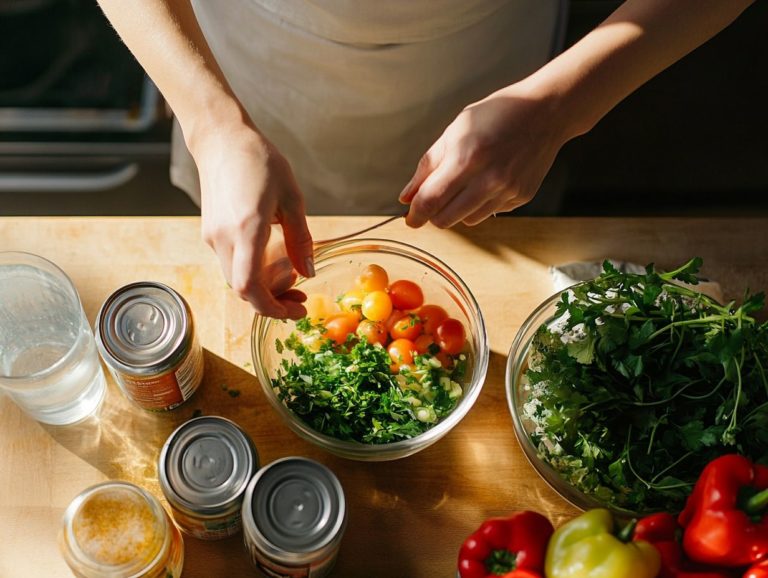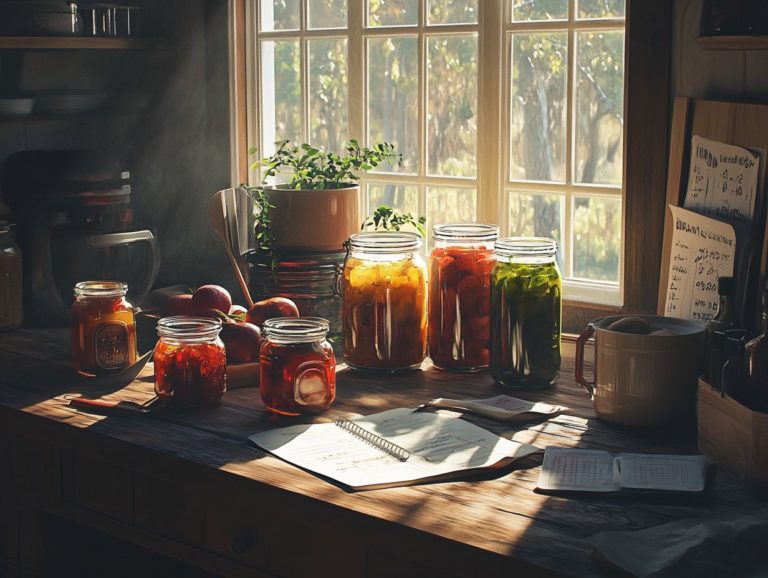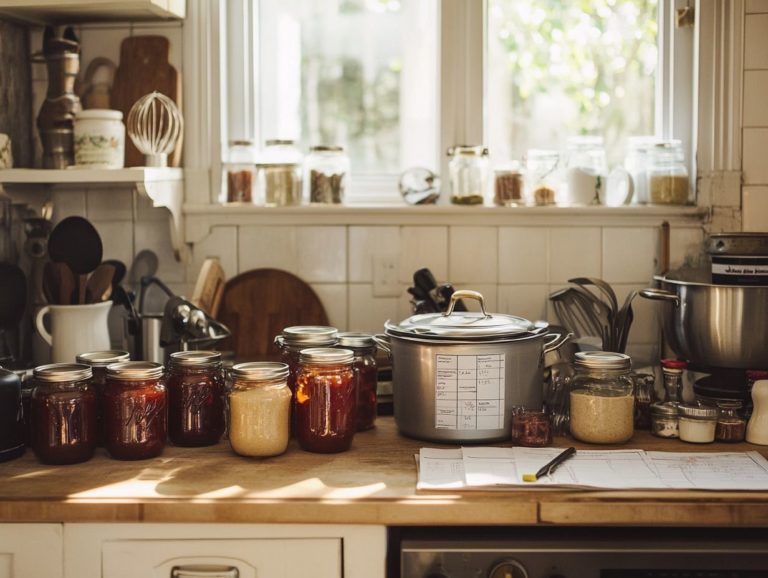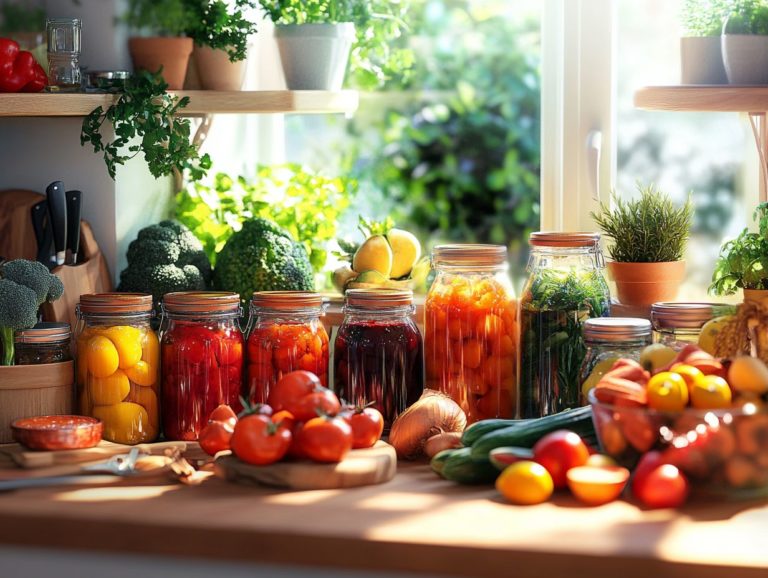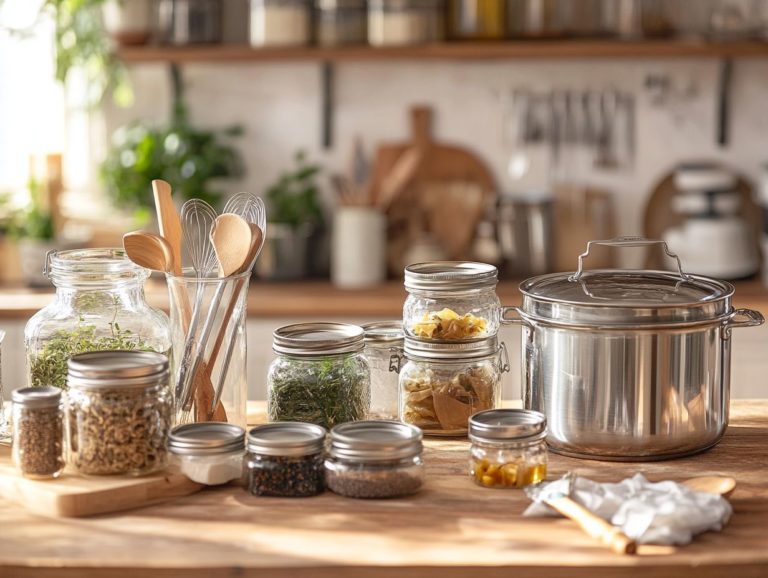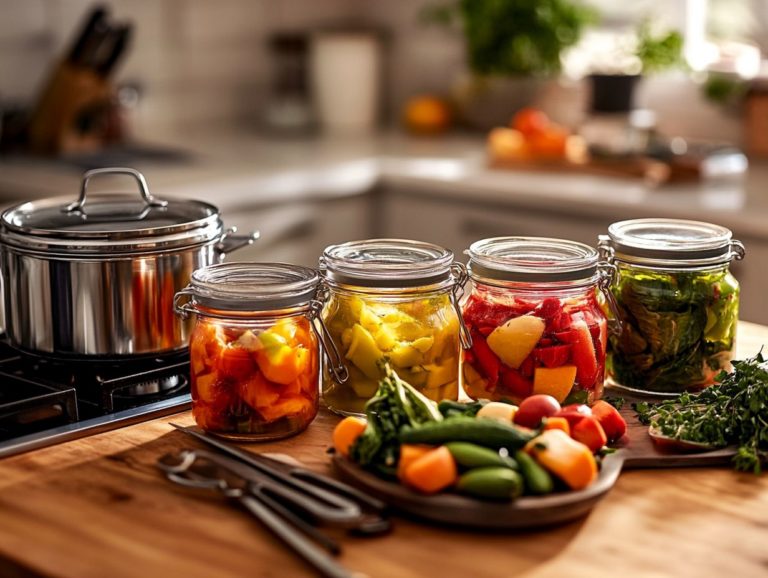5 Common Canning Problems and Solutions
Canning offers a delightful way to preserve the vibrant flavors of your harvest, yet it does come with its own set of challenges. From jars that refuse to seal to unexpected spoilage, these mishaps can easily transform your hard work into moments of frustration. This article delves into five common canning problems, equipping you with practical solutions and best practices to ensure your canned goods are both safe and delicious. Whether you re a seasoned canner or just beginning your journey, you ll discover valuable tips designed to elevate your canning experience and fully savor the fruits of your labor.
Contents
- Key Takeaways:
- 1. Jars Not Sealing Properly
- 2. Food Spoiling During Storage
- 3. Cloudy Liquid or Floating Food
- 4. Mold Growth
- 5. Loss of Liquid During Processing
- How to Ensure Jars Seal Properly?
- What Are the Best Practices for Storing Canned Foods?
- How to Prevent Cloudy Liquid or Floating Food?
- What Are the Signs of Spoiled Canned Foods?
- What Are the Possible Causes of Canning Problems?
- How to Troubleshoot Common Canning Problems?
- How to Properly Clean and Sterilize Jars for Canning?
- What Are Some Tips for Successful Canning?
- What Are the Safety Precautions for Canning?
- How to Store Canned Foods for Long-Term Use?
- What Are the Benefits of Canning Foods at Home?
- What Are the Different Methods of Canning?
- How to Choose the Right Foods for Canning?
- What Are Common Mistakes Made in Canning?
- How to Safely Can Low-Acid Foods?
- Frequently Asked Questions
- 1. What are some common problems that can occur during the canning process?
- 2. How can I prevent jars from breaking or cracking during canning?
- 3. What should I do if the lids don’t seal properly during the canning process?
- 4. What causes food spoilage in canned goods and how can I prevent it?
- 5. Why does my preserved food sometimes turn discolored?
- 6. Can I still eat canned food that has gone bad?
Key Takeaways:
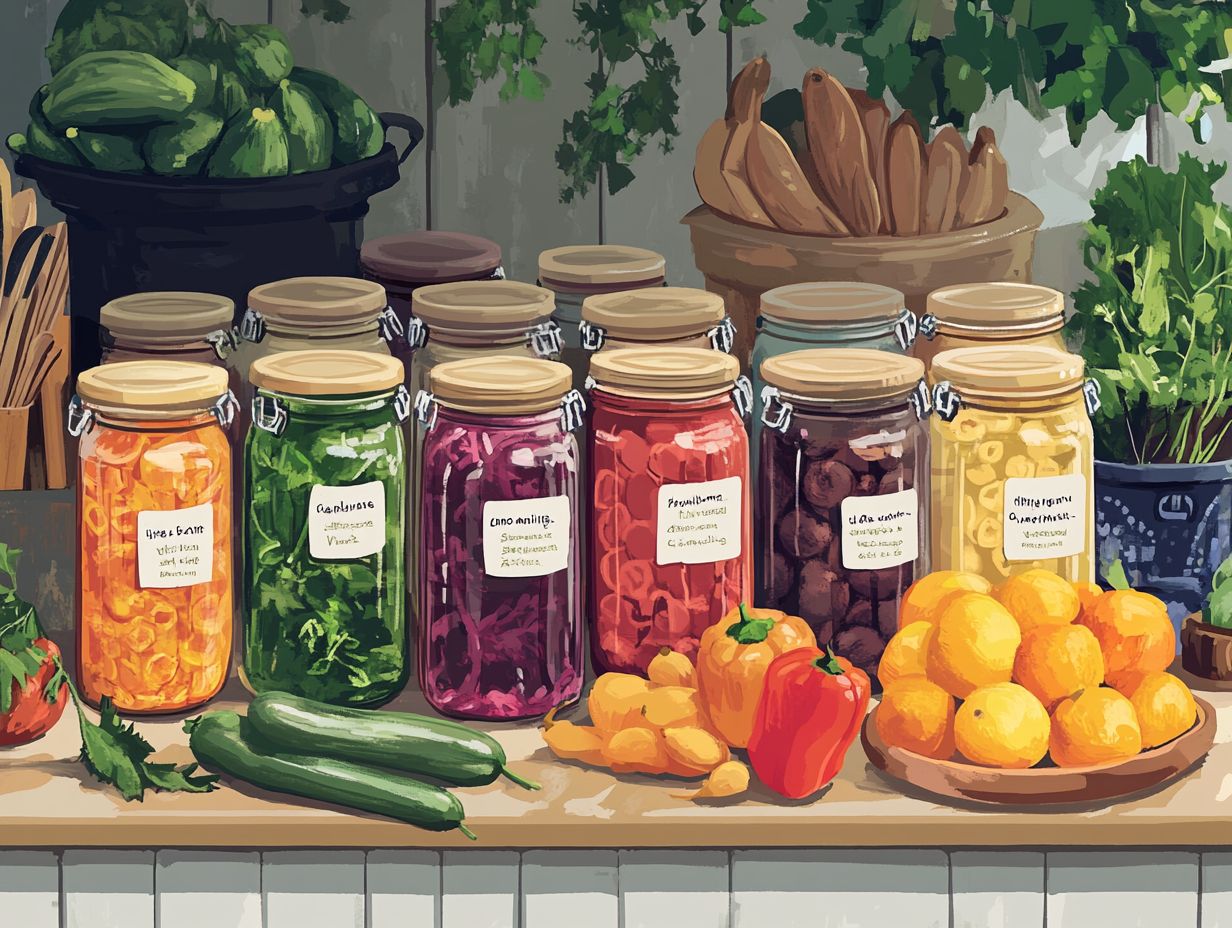
- Ensure jars are properly sealed to avoid spoilage.
- Store canned foods in a cool, dark place for best preservation.
- Prevent cloudy liquid or floating food by using fresh ingredients.
1. Jars Not Sealing Properly
One of the most frustrating issues you might encounter in home canning is when jars refuse to seal properly. This can lead to food safety risks, such as spoilage and even the potential for botulism. Botulism is a rare but serious illness caused by spoiled food, especially when you re preserving items like venison or fruits. Proper sealing is essential to create a vacuum during the canning process that keeps harmful bacteria at bay, so it s crucial to follow USDA guidelines and check all your equipment meticulously.
Several common culprits can lead to this vexing outcome. A frequent issue arises from using warped or damaged lids, which prevent a secure seal. Make sure to clean jars and lids properly, as residue can interfere with sealing. Additionally, referring to canning techniques: troubleshooting tips can help resolve issues, as improper processing methods, such as spending too little time in the water bath or pressure cooker, can also contribute to canning failures.
To troubleshoot these problems effectively, inspect lids for any imperfections, ensure that all your tools are sanitized, and adhere strictly to the recommended processing times and temperatures. For more insights, check out common canning errors and how to fix them. By taking these steps, not only will you enhance food safety, but you’ll also pave the way for a successful canning experience.
2. Food Spoiling During Storage
Food spoilage during storage can be a major letdown for your canning efforts, especially when employing methods like hot pack or cold pack for fruits and vegetables. Improper sealing or inadequate processing times can lead to unwanted spoilage and contamination.
This challenge becomes even more pronounced with fluctuating temperatures and less-than-ideal storage conditions, where jars might be subjected to light, humidity, or extreme heat. To safeguard your efforts, it’s vital to use clean jars and lids to minimize the introduction of bacteria or other microorganisms that could compromise food quality.
Regular inspections of your stored foods are equally important. Look for indicators like bulging lids, leaks, or off-odors to catch any spoilage early on. If you see signs of spoilage, act quickly! Discard those jars to keep your family safe.
3. Cloudy Liquid or Floating Food
Cloudy liquid or floating food in your canned jars can signal potential issues with the canning process, particularly concerning the quality of the food or the methods you’ve used. This can impact the aesthetic appeal and perceived safety of your preserved items.
That cloudiness often comes from trapped air bubbles, which can form when the food isn t packed tightly enough or when your jars aren t filled to the recommended level. If your boiling techniques are lacking like not processing for the right amount of time or using uneven heating these problems can worsen. It s also essential to consider the quality of the food you re using; overripe or damaged produce can lead to less-than-desirable results.
To avoid these pitfalls, stick to best practices in food preparation. Make sure your fruits and vegetables are fresh and free of blemishes, and meticulously follow canning guidelines. This diligence will significantly enhance the quality of your final product.
4. Mold Growth
Act quickly to prevent mold growth your health depends on it! Mold growth is a significant concern during the canning process, as it can signal potential harmful bacteria or substances during food preparation or inadequate sealing. This not only jeopardizes food safety but also poses considerable health risks if consumed.
You may encounter various types of mold on canned foods, including Aspergillus, Penicillium, and Rhizopus, each showcasing unique colors and textures. Aspergillus might present itself with a greenish tint, while Penicillium often appears as a bluish, fuzzy mold. Rhizopus, in contrast, tends to manifest as a darker mold.
To thwart this unwelcome growth, it’s crucial to meticulously clean all equipment and surfaces prior to canning. Ensuring that jars are sealed properly and storing canned goods in a cool, dry environment are also essential steps. Regularly inspecting stored foods for any signs of spoilage will help you maintain both safety and quality.
5. Loss of Liquid During Processing
Loss of liquid during the canning process can significantly compromise the safety and quality of preserved foods, such as venison and fruits. When air seeps into the jars, it introduces a risk of contamination and spoilage that you definitely want to avoid.
Common culprits behind this issue often include improper boiling water techniques. If you don’t give it enough time or the right temperature, evaporation can occur. Additionally, troubleshooting your canning process by using correct methods can help ensure you achieve those all-important airtight seals.
To keep your liquid levels just right, it s crucial to fill the jars to the recommended headspace the space between the top of the food and the lid of the jar. This allows for proper expansion and helps create a vacuum seal. Don t overlook the importance of vacuum sealing; it minimizes the risk of air being trapped in jars, preserving the freshness and safety of your stored food.
How to Ensure Jars Seal Properly?
Let s make sure your jars seal perfectly during the canning process! It’s essential to adhere to the strict guidelines and procedures recommended by the USDA. This includes using clean, sterilized jars and lids, maintaining the correct temperature, and inspecting for a proper vacuum seal after processing.
Preparing your ingredients is equally crucial. Wash and cut them uniformly, as uneven sizes can disrupt the sealing process. Once your jars are filled with the prepared produce, take a moment to wipe down the rims to eliminate any residue that could interfere with a proper seal. During sealing, remember to apply the correct amount of headspace, allowing just enough room for expansion.
After canning, allow the jars to cool completely before inspecting each seal for integrity. A properly sealed jar will have a slight inward curve at the center of the lid; if it pops when pressed, you ll know it hasn’t sealed correctly.
Labeling your jars with the canning date and expiration dates is essential for proper storage and timely consumption, ultimately contributing to food safety and quality.
What Are the Best Practices for Storing Canned Foods?
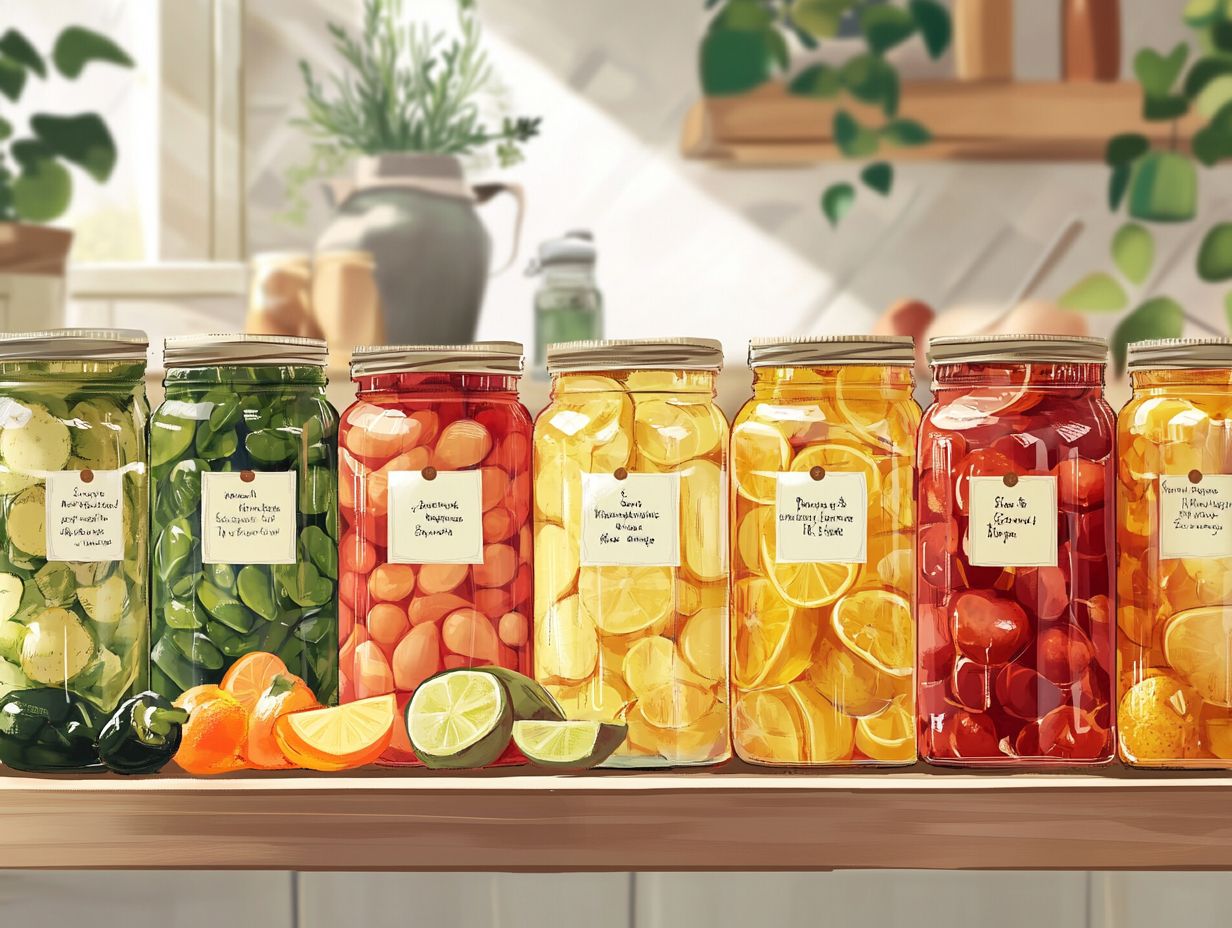
Best practices for storing canned foods are essential for ensuring food safety and extending shelf life. Always use clean, airtight jars and keep them in a cool, dark place. Always check for spoilage signs before using your canned goods.
Temperature and humidity control play a crucial role in maintaining the longevity and safety of your stored goods. Proper ventilation is key; it helps prevent moisture buildup, which can lead to spoilage and degrade food quality. Minimizing light exposure is also vital, as UV rays can break down the contents over time. Don t overlook routine checks these provide valuable opportunities to evaluate conditions and catch any potential issues early on.
Choosing the right packaging materials that create a barrier against air and moisture can significantly enhance preservation. This proactive approach safeguards against spoilage and ensures optimal storage conditions for your canned foods.
How to Prevent Cloudy Liquid or Floating Food?
Preventing cloudy liquid or floating food in your canned goods demands a keen eye for detail throughout the canning process. Start with fresh ingredients and pack your jars with care.
Adhere to the recommended processing times to guarantee the highest quality of your food. Thoroughly sterilizing all your equipment is essential; this greatly diminishes the risk of contamination, which is vital for achieving clarity and consistency in your final product.
Keep a watchful eye on cooking temperatures. Excessive heat can break down food and create textures you d rather avoid. Stick to trusted recipes for valuable guidance and the latest food safety practices.
By combining meticulous technique with established methods, you ll preserve not just the flavors but also the visual appeal of your creations while extending their shelf life.
What Are the Signs of Spoiled Canned Foods?
Recognizing the signs of spoiled canned foods is essential for your food safety. Look out for indicators like bulging lids, off smells, or unusual colors. These can signal contamination that poses health risks when consuming preserved items.
If you notice any leaks or rust on the can, those could further suggest spoilage. Conduct thorough inspections before using canned goods, as overlooking these signs can lead to serious health issues like food poisoning.
When in doubt, the safest course of action is to discard the item. Always err on the side of caution and avoid consuming it. By staying vigilant about these indicators, you can maintain safety in your kitchen and prevent adverse health effects from spoiled foods.
What Are the Possible Causes of Canning Problems?
Knowing the causes of canning problems can help you preserve your food safely. Issues like improper sealing, unsuitable ingredients, and inadequate processing can lead to contamination and spoilage of your canned goods. For more insights, check out these frequently asked canning troubleshooting questions.
One primary concern in home canning is the risk of botulism, a potentially fatal illness from toxins produced by bacteria that thrive in improperly canned foods. For low-acid foods, using a water bath method instead of a pressure canner creates a breeding ground for harmful bacteria.
That’s why it’s essential to follow USDA guidelines, which provide specific instructions for safe canning practices. To avoid common issues, refer to common canning mistakes and how to avoid them. When troubleshooting, start by checking your lid seals; if they aren’t airtight, you may face spoilage.
Inspect jars for any signs of spoilage to ensure a safe and enjoyable canning experience.
How to Troubleshoot Common Canning Problems?
Troubleshooting common canning problems is an invaluable skill for you as a home canner. Spot issues like jar seal failures, cloudy liquids, or spoilage before they escalate into unsafe food storage.
This skill is essential for maintaining the quality and safety of the preserved foods you relish throughout the year. It helps you protect the integrity of your canned goods and gives you the power to take swift corrective actions.
By adhering to established techniques and safety guidelines, you can confidently address challenges such as improper headspace or inadequate processing times. For more help, check out these tips for preventing canning failures to ensure each jar is a resounding success.
Having a comprehensive checklist at your fingertips can significantly streamline the troubleshooting process, providing a clear pathway to quickly identify and resolve potential issues.
How to Properly Clean and Sterilize Jars for Canning?
Properly cleaning and sterilizing your jars is essential in the canning process. It removes contaminants and ensures food safety, significantly reducing the risk of spoilage and botulism in your preserved items, whether it s venison or fruits.
To kick things off, inspect each jar meticulously for any cracks or chips.
Damaged jars could undermine the integrity of the food you re preserving.
Once you confirm that your jars are in good shape, it s time to clean. A tried-and-true method is to boil water just submerge the jars in a large pot, making sure they re fully covered, and let them boil for about 10 minutes.
If you prefer a more modern approach, using the sanitize cycle on your dishwasher can be a highly efficient option. After the cleaning process, allow the jars to air dry on a pristine towel to ensure they remain uncontaminated before you fill them with your carefully prepared goods.
What Are Some Tips for Successful Canning?
Successful canning requires your focus on the little things and a commitment to best practices. This means using fresh ingredients, following tested recipes, and adhering to proper processing times and temperatures to ensure food safety.
As you embark on this process, begin with thorough preparation.
Gather all the necessary tools, such as sterilized jars, lids, and canning equipment, to create an efficient workspace. Cleanliness is paramount; ensuring that everything is sanitized will help you prevent contamination and spoilage.
Consulting USDA recommendations is wise, as they offer invaluable insights into safe canning techniques.
When you choose your ingredients, prioritize high-quality produce that s in season. This choice will elevate both the flavor and texture of your final product.
By following these guidelines, you can enjoy a rewarding canning experience that yields delicious results.
What Are the Safety Precautions for Canning?
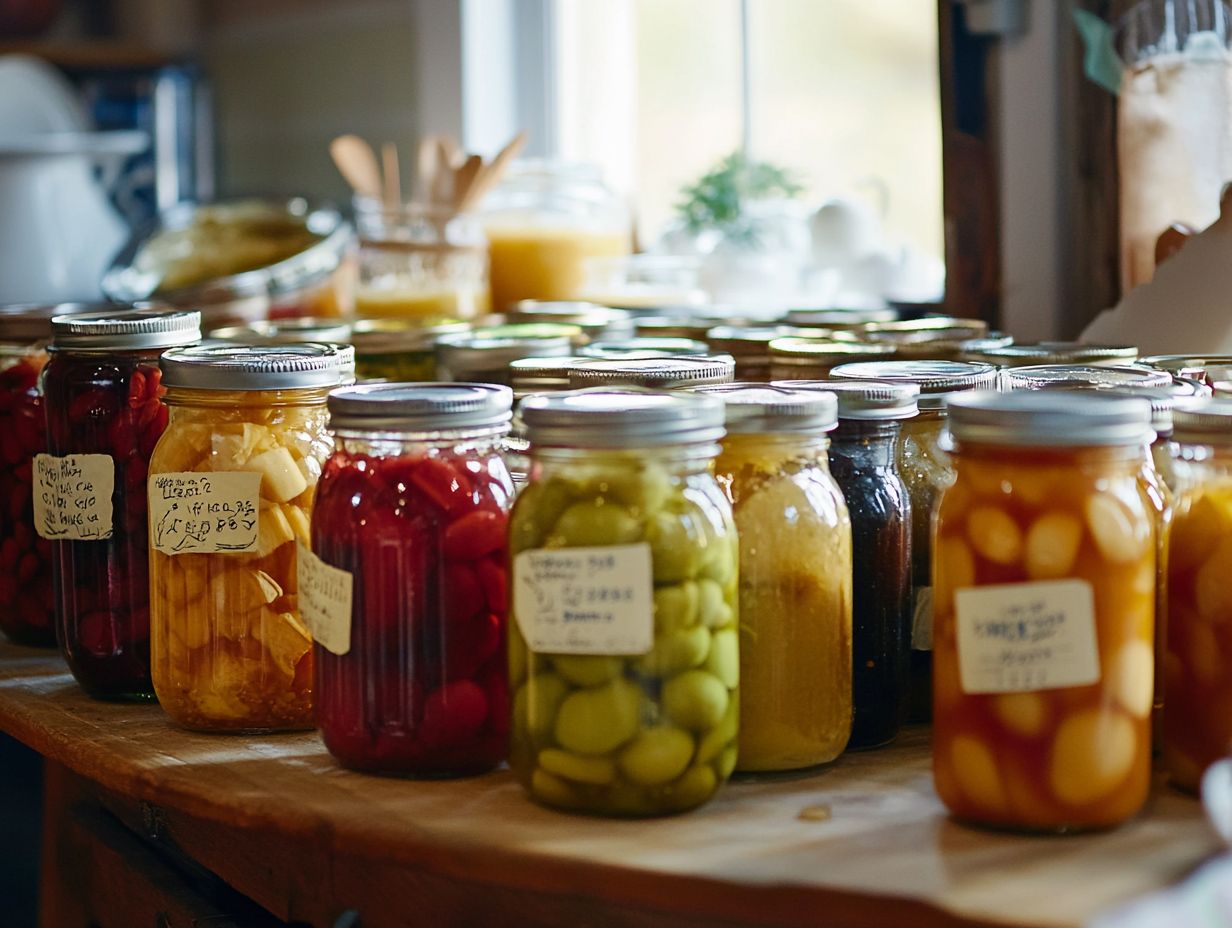
You must implement safety precautions during the canning process to prevent foodborne illnesses. Ensure that all equipment is sanitized, processing times are meticulously followed, and the proper methods are utilized to seal jars effectively.
Utilizing USDA-approved recipes is crucial for maintaining the correct acidity levels, significantly reducing the risk of botulism and other harmful bacteria. These guidelines not only ensure safe preservation but also elevate the overall quality of your canned products.
Improper canning techniques, such as neglecting temperature regulations or skipping necessary sterilization steps, can pose serious health hazards. Therefore, it s vital for you to understand and diligently implement these safety measures for a safe and enjoyable canning experience.
How to Store Canned Foods for Long-Term Use?
Storing canned foods for the long haul requires you to carefully consider environmental factors like temperature, humidity, and light exposure to maintain quality and safety over time.
Opting for a cool, dark space think basement or pantry is an excellent choice!
Temperatures ideally hover between 50 F and 70 F. Keeping humidity levels low is crucial to prevent rusting on those cans.
Arranging your stored goods in an orderly fashion not only makes for easier access but also encourages a first-in, first-out approach, ensuring you use older items before newer ones.
You must regularly inspect your stash! Look for signs of spoilage, such as bulging lids or leaks, to avoid the risks of consuming compromised food.
Staying vigilant not only safeguards your health but also enhances your food storage efficiency.
Ready to start your canning journey? Let’s preserve deliciousness together!
What Are the Benefits of Canning Foods at Home?
Canning foods at home offers numerous advantages. It provides superior food preservation, enhances safety through controlled methods, and allows you to customize flavors while saving money on store-bought products!
By embracing home canning, you can take full advantage of seasonal produce. This method locks in the peak flavors and nutritional benefits of fruits and vegetables. Not only does it help reduce food waste, but it also fosters a sense of accomplishment and creativity in your kitchen.
Experimenting with different recipes can transform canning into a fun project that brings families together. It promotes healthy eating habits and ignites culinary exploration. By controlling the quality of your ingredients, you can savor wholesome, chemical-free foods that are uniquely tailored to your taste!
What Are the Different Methods of Canning?
There are several methods of canning available, such as pressure canning and boiling water canning. Each method is designed for specific food types and follows safety guidelines that ensure your jars are sealed correctly.
Understanding these differences is crucial for anyone looking to preserve their harvest or store food for extended periods. Pressure canning is best for low-acid foods, like vegetables and meats, because it reaches high temperatures to eliminate harmful bacteria. In contrast, boiling water canning is perfect for high-acid foods, such as fruits and pickles, where the acidity helps inhibit the growth of pathogens.
It’s essential to follow safety protocols with both methods to prevent spoilage and maintain the nutritional integrity of your food. This diligence not only safeguards your preserves but also protects the health of everyone who will enjoy them!
How to Choose the Right Foods for Canning?
Selecting the right foods for canning is key for successful preservation. Factors like acidity level, freshness, and compatibility with canning methods greatly affect the safety and quality of your final product.
Fresh produce adds more flavor and packs essential nutrients for the longevity of your canned items. When deciding what to can, it’s important to understand the acidity levels of different fruits and vegetables. High-acid options like tomatoes and strawberries can be safely processed using a water bath canning method. Meanwhile, low-acid foods, such as carrots and green beans, require pressure canning to reduce any risk of botulism.
By choosing vibrant, ripe produce, you can create delicious canned goods whether it s tangy pickles, sweet jams, or hearty stews making all your efforts truly worthwhile!
What Are Common Mistakes Made in Canning?
Common mistakes in canning can lead to significant food safety violations and spoilage. It’s crucial to be diligent in following procedures to ensure the safe preservation of foods like venison and various fruits.
Frequent errors include under-processing jars, which can allow harmful bacteria to survive in the sealed environment. Not using the appropriate equipment, like pressure canners for low-acid foods, can compromise safety. Additionally, failing to check seals after processing is another mistake that can lead to product spoilage. For guidance on these common pitfalls, refer to canning storage issues troubleshooting. These oversights don’t just affect the quality of your canned goods; they can also pose health risks to those who consume them.
To avoid these pitfalls, it’s vital to strictly adhere to guidelines provided by the USDA. Regularly inspect your equipment, including lids and jars, and ensure all seals are intact before storing your preserved foods.
How to Safely Can Low-Acid Foods?
Safely canning low-acid foods requires specific techniques and equipment, such as a pressure cooker or boiling water canner, to effectively remove harmful bacteria and prevent botulism. This ensures your food remains safe.
Start by gathering essential tools, including mason jars, lids, and a reliable pressure canner. Carefully clean all your equipment and ingredients; cleanliness is crucial.
Next, fill the jars with your selected low-acid food, making sure to leave the appropriate headspace, which is the space left at the top of the jar for expansion. Securely fasten the lids to the jars, ensuring a tight seal.
Then, preheat the pressure canner according to the manufacturer’s instructions, ensuring it reaches the required temperature. Follow USDA guidelines and adhere to the recommended processing times for the specific food type; this step is vital for removing any potential pathogens.
Finally, allow the jars to cool completely before storing them. You’ll love the results of your canning efforts!
Frequently Asked Questions
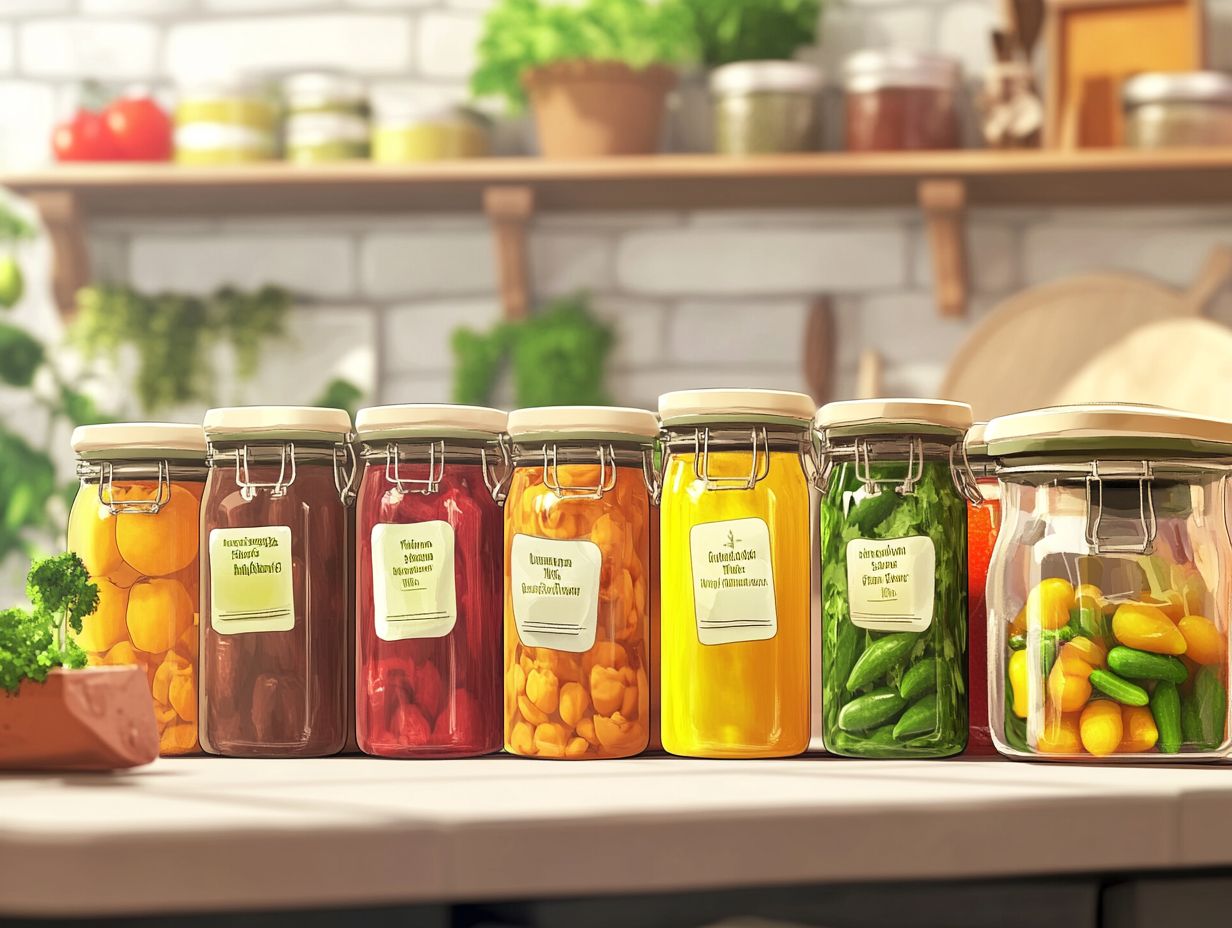
1. What are some common problems that can occur during the canning process?
Common problems during canning include jars breaking or cracking, lids not sealing properly, food spoilage, and discoloration of the preserved food. For more insights, check out common canning mistakes and their solutions.
2. How can I prevent jars from breaking or cracking during canning?
To prevent jars from breaking or cracking, use jars specifically designed for canning and follow the recommended processing time for the type of food you are preserving. Avoid extreme changes in temperature, like placing hot jars in cold water.
3. What should I do if the lids don’t seal properly during the canning process?
If the lids don’t seal properly, reprocess the jars by removing the lid and rim, cleaning the rim, and resealing the jar with a new lid. If this process does not work, safely refrigerate the food and eat it within a few days.
4. What causes food spoilage in canned goods and how can I prevent it?
Food spoilage in canned goods is usually caused by improper sealing, inadequate processing time, or contamination during the canning process. Follow proper canning techniques and use fresh, high-quality ingredients to prevent spoilage.
5. Why does my preserved food sometimes turn discolored?
Discoloration can be caused by using old or spoiled ingredients, improper processing or storage, or exposure to air during the canning process. Always use fresh ingredients and follow recommended processing and storage guidelines to avoid discoloration.
6. Can I still eat canned food that has gone bad?
No, if your canned food shows signs of spoilage, such as mold or a foul odor, it should not be consumed. It’s vital to follow proper canning techniques and guidelines to ensure the safety and quality of your preserved food.
Start preserving your favorite foods today and enjoy the taste of home all year round!

